

Ciguatera fish poisoning after Caribbean travel. Extracorporeal membrane oxygenation. Extracorporeal membrane oxygenation (ECMO), also known as extracorporeal life support (ECLS), is an extracorporeal technique of providing prolonged cardiac and respiratory support to persons whose heart and lungs are unable to provide an adequate amount of gas exchange or perfusion to sustain life.

The technology for ECMO is largely derived from cardiopulmonary bypass, which provides shorter-term support with arrested native circulation. This intervention has mostly been used on children, but it is seeing more use in adults with cardiac and respiratory failure, especially in treatment of viral pneumonia caused by the COVID-19 Coronavirus[1]. ECMO works by removing blood from the person's body and artificially removing the carbon dioxide and oxygenating red blood cells. History[edit] ECMO was first developed in the 1950s by John Gibbon, and then by C. Medical uses[edit] In those with cardiac arrest or cardiogenic shock, it appears to improve survival and good outcomes.[6] Biocentrism (ethics) Biocentrism does not imply the idea of equality among the animal kingdom, for no such notion can be observed in nature.
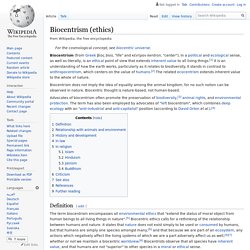
Biocentric thought is nature-based, not human-based. The four main pillars of a biocentric outlook are: Biocentrism views individual species as parts of the living biosphere. It observes the consequences of reducing biodiversity on both small and large scales and points to the inherent value all species have to the environment. The environment is seen for what it is; the biosphere within which we live and depend on its diversity for our health. Plane (esotericism) A subtle state, level, or region of reality In esoteric cosmology, a plane is conceived as a subtle state, level, or region of reality, each plane corresponding to some type, kind, or category of being.

The concept of planes of existence might be seen as deriving from shamanic and traditional mythological ideas of a vertical world-axis—for example a cosmic mountain, tree, or pole (such as Yggdrasil or Mount Meru)—or a philosophical conception of a Great Chain of Being, arranged metaphorically from God down to inanimate matter. Directly equivalent concepts in Indian thought are lokas and bhuvanas. In Hindu cosmology, there are many lokas or worlds, that are identified with both traditional cosmology and states of meditation.
The ancient Norse mythology gave the name "Ginnungagap" to the primordial "Chaos", which was bounded upon the northern side by the cold and foggy "Niflheim"—the land of mist and fog—and upon the south side by the fire "Muspelheim". Occultist George Arundale wrote: Speleology. Science of cave and karst systems Grotte des Faux-Monnayeurs, Mouthiers-Haute-Pierre (France) Speleology is the scientific study of caves and other karst features, as well as their make-up, structure, physical properties, history, life forms, and the processes by which they form (speleogenesis) and change over time (speleomorphology).
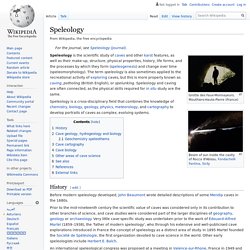
The term speleology is also sometimes applied to the recreational activity of exploring caves, but this is more properly known as caving, potholing (British English), or spelunking. Asian brown cloud. Atmospheric Brown Cloud over China Big Brown Cloud Storm over Asia The Indian Ocean brown cloud or Asian brown cloud is a layer of air pollution that recurrently covers parts of South Asia, namely the northern Indian Ocean, India, and Pakistan.[1][2] Viewed from satellite photos, the cloud appears as a giant brown stain hanging in the air over much of South Asia and the Indian Ocean every year between January and March, possibly also during earlier and later months.

The term was coined in reports from the UNEP Indian Ocean Experiment (INDOEX).[3] The term atmospheric brown cloud is used for a more generic context not specific to the Asian region.[4] Noble metal. Metals resistant to corrosion and oxidation In chemistry, the noble metals are metals that are resistant to corrosion and oxidation in moist air (unlike most base metals).
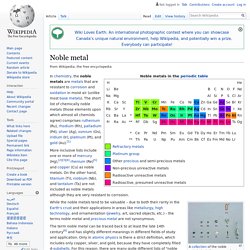
The short list of chemically noble metals (those elements upon which almost all chemists agree) comprises ruthenium (Ru), rhodium (Rh), palladium (Pd), silver (Ag), osmium (Os), iridium (Ir), platinum (Pt), and gold (Au).[1] Base metal. A base metal is a common and inexpensive metal, as opposed to a precious metal such as gold or silver.[1] A long-time goal of alchemists was the transmutation of a base (low grade) metal into a precious metal.
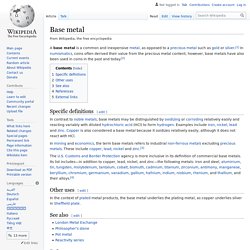
In numismatics, coins often derived their value from the precious metal content; however, base metals have also been used in coins in the past and today. Specific definitions[edit] Refractory metals. Definition[edit] Most definitions of the term 'refractory metals' list the extraordinarily high melting point as a key requirement for inclusion.

By one definition, a melting point above 4,000 °F (2,200 °C) is necessary to qualify.[2] The five elements niobium, molybdenum, tantalum, tungsten and rhenium are included in all definitions,[3] while the wider definition, including all elements with a melting point above 2,123 K (1,850 °C), includes a varying number of nine additional elements: titanium, vanadium, chromium, zirconium, hafnium, ruthenium, rhodium, osmium and iridium. The artificial elements, being radioactive, are never considered to be part of the refractory metals, although technetium has a melting point of 2430 K or 2157 °C and rutherfordium is predicted to have melting point of 2400 K or 2100 °C.[4] Properties[edit] Physical[edit]
Dermatoglyphics. Dermatoglyphics (from Ancient Greek derma, "skin", and glyph, "carving") is the scientific study of fingerprints, lines, mounts and shapes of hands, as distinct from the superficially similar pseudoscience of palmistry.

Dermatoglyphics also refers to the making of naturally occurring ridges on certain body parts, namely palms, fingers, soles, and toes. These are areas where hair usually does not grow, and these ridges allow for increased leverage when picking up objects or walking barefoot. In a 2009 report, the scientific basis underlying dermatoglyphics was questioned by the National Academy of Sciences, for the discipline's reliance on subjective comparisons instead of conclusions drawn from the scientific method.[1]
What is the strongest type of radiation? How can you protect yourself from its damage? Rigor mortis. Rigor mortis (Latin: rigor "stiffness", mortis "of death") or postmortem rigidity, the third stage of death, is one of the recognizable signs of death, caused by chemical changes in the muscles post mortem, which cause the limbs of the corpse to stiffen.[1] In humans, rigor mortis can occur as soon as 4 hours post mortem.
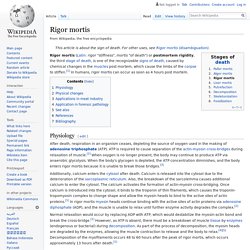
Physiology[edit] After death, respiration in an organism ceases, depleting the source of oxygen used in the making of adenosine triphosphate (ATP). ATP is required to cause separation of the actin-myosin cross-bridges during relaxation of muscle.[2] When oxygen is no longer present, the body may continue to produce ATP via anaerobic glycolysis. When the body's glycogen is depleted, the ATP concentration diminishes, and the body enters rigor mortis because it is unable to break those bridges.[3] Additionally, calcium enters the cytosol after death. Physical changes[edit] Solvay Conference. Photograph of the first conference in 1911 at the Hotel Metropole. Seated (L-R): W. Nernst, M. Brillouin, E. Solvay, H. Lordosis. Lordosis is the normal inward lordotic curvature of the lumbar and cervical regions of the human spine.[1] The normal outward (convex) curvature in the thoracic and sacral regions is termed kyphosis or kyphotic. The term comes from the Greek lordōsis, from lordos ("bent backward").[2] Lumbar hyperlordosis is excessive extension of the lumbar region, and is commonly called hollow back or saddle back (after a similar condition that affects some horses).
Lumbar kyphosis is an abnormally straight (or in severe cases flexed) lumbar region. These conditions are usually a result of poor posture and can often be reversed by learning correct posture and using appropriate exercises.[4] Types[edit] Lumbar lordosis[edit] What Is an Orthopedic Surgeon? - Orthopedic Surgery. An orthopedic surgeon, or orthopaedic surgeon, is a surgeon who has been educated and trained in the diagnosis and preoperative, operative, and postoperative treatment of diseases and injuries of the musculoskeletal system. Orthopedic surgeons work closely with other health care providers and often serve as consultants to other physicians. Orthopedic surgeons often are involved in education (e.g., medical school professors) or research. Aerogel. A block of aerogel in a person's hand Aerogel was first created by Samuel Stephens Kistler in 1931, as a result of a bet with Charles Learned over who could replace the liquid in "jellies" with gas without causing shrinkage.[3][4] IUPAC definition.
Actio et reactio. What Does Demisexual Mean? Here Are 6 Signs That You May Identify As Demisexual. Coriolis force. A force on objects moving within a reference frame that rotates with respect to an inertial frame. In the inertial frame of reference (upper part of the picture), the black ball moves in a straight line. Crown shyness. Possible physiological explanations[edit] The exact physiological basis of crown shyness is not certain.[6] The phenomenon has been discussed in scientific literature since the 1920s.[9] The variety of hypotheses and experimental results might suggest that there are multiple mechanisms across different species, an example of convergent evolution. Some hypotheses contend that the interdigitation of canopy branches leads to “reciprocal pruning” of adjacent trees. Trees in windy areas suffer physical damage as they collide with each other during winds. Placebo. Substance or treatment of no therapeutic value.
Laminar flow. A sphere in Stokes flow, at very low Reynolds number. An object moving through a fluid experiences a force in the direction opposite to its motion. In fluid dynamics, laminar flow (or streamline flow) occurs when a fluid flows in parallel layers, with no disruption between the layers.[1] At low velocities, the fluid tends to flow without lateral mixing, and adjacent layers slide past one another like playing cards. Archerfish. The NASA data conspiracy theory and the cold sun « RealClimate. Consent Form. Scientists Finally Have Evidence That Frigatebirds Sleep While Flying. Arc flash. Doppler effect. Tourette syndrome.
Tourette syndrome (TS or simply Tourette's), is a common neuropsychiatric disorder with onset in childhood,[1] characterized by multiple motor tics and at least one vocal (phonic) tic. Earth leakage circuit breaker. An Earth-leakage circuit breaker (ELCB) is a safety device used in electrical installations with high Earth impedance to prevent shock. Epilepsy Foundation. Pap Smear (Pap Test): Reasons, Procedure, & Results. Continuum and the Bootstrap Paradox - The Quantum Tunnel. Continuum’s present timeline seems to be littered with objects from the future. This is hardly surprising considering it is a time travel show. Objects like Kiera’s CMR, the Quantum Time Traveling Device, the drug Retrievanol better known as “Flash” and that other mysterious device whose purpose we are yet to learn all exist in a time when they should not as they have not been created. Oligodynamic effect. Top 10 Most Beautiful Extinct Animals. Megafauna: why large animals are becoming extinct, again.
What Does STEM Stand for? Coanda Effect. "Joke Addiction" As A Neurological Symptom - Neuroskeptic. Autonomous sensory meridian response. Smithsonian - Chladni Plates.
Fossil hunters unearth galloping, dinosaur-eating crocodiles in Sahara. Experimental science. What Causes Morning Wood? Hermaphrodite. Running With Mexico's Tarahumara Indians. List of landings on extraterrestrial bodies - Wikipedia. Curiosity (rover) - Wikipedia. What is eugenics? – pgEd. Why Time Seems to Slow Down in Emergencies. How can wormholes be used for time travel? Io9.gizmodo. Wipe Out: History's Most Mysterious Extinctions. What If the Yellowstone Supervolcano Erupts? Summer solstice: Why the latest sunset time doesn't fall on the longest day of the year - Science News - ABC News. Is The Neutrino A Tachyon? Spacechem. Three Ways To Tell Animal Bones From Human Bones.
New Form Of Atomic Nuclei Just Confirmed, And it Suggests Time Travel is Impossible. Branches of Science. Big Think - Nikola Tesla is probably the most accurate... Is Mathematics a Science? What is the difference between a PhD degree and a DSc degree? - Academia Stack Exchange. Why don't humans have mating seasons? : askscience. Clinically Dead? The Blurred Line Between Life and Death. Darwin’s Finches and Natural Selection in the Galapagos. Why do cats love boxes? Scientists say it could be predatory behavior. Her Code Got Humans on the Moon—And Invented Software Itself. Finally! A Human-Powered Helicopter Wins the $250,000 Sikorsky Prize. This Millennial Might Be the New Einstein. Ten Young Geniuses Shaking Up Science Today.
The Real Physics Of Ant-Man: Blind, Deaf, And His Voice Would Be Hilarious.